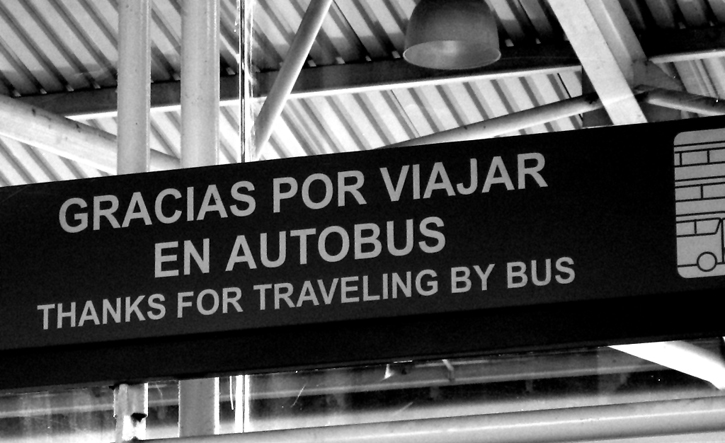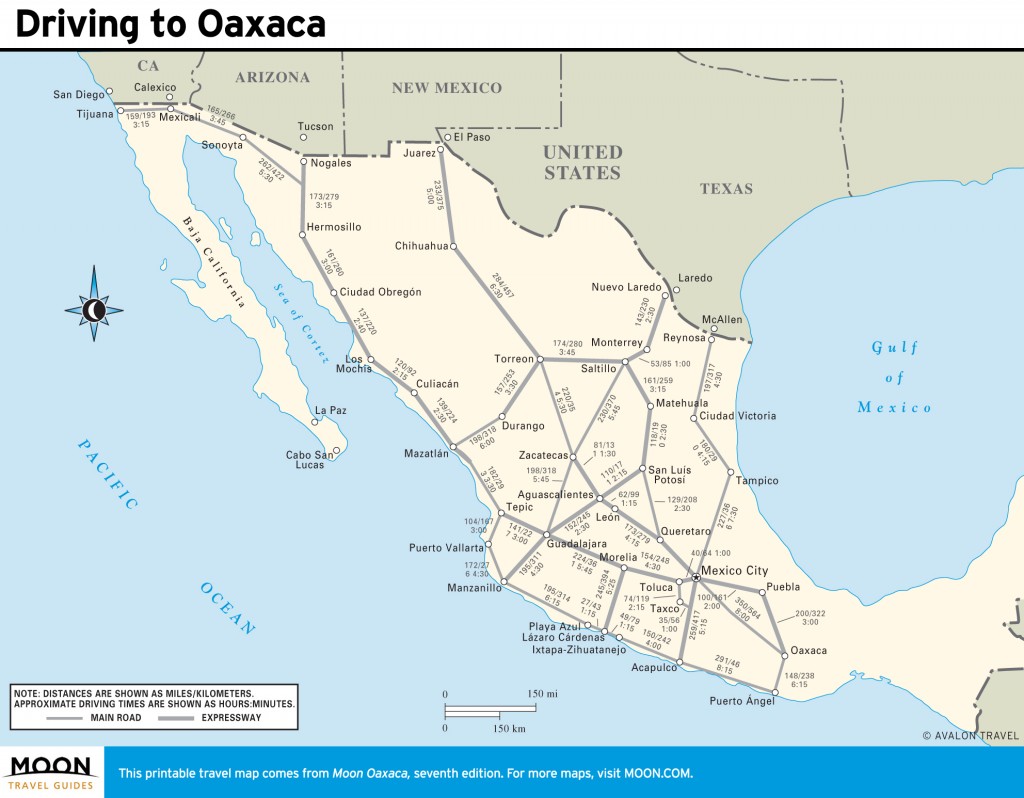
Travel to and through Oaxaca by Bus. Photo © Ryan, licensed Creative Commons Attribution.
Finally, after taking a taxi to the bus station, handy words to have in mind are taquilla (ticket booth), guardaequipajes (baggage checkroom), llegada (arrival), salida (departure), and sanitario or baño (toilet or bathroom).
First- and luxury-class bus service in Mexico is generally cheaper and better than in the United States. Tickets for comparable trips in Mexico cost less than half (as little as $100 for a 1,600-km/1,000-mi trip), compared to perhaps $200 in the United States.
In Mexico, as on U.S. buses, you often have to take it as you find it. Asientos reservados (reserved seats), boletos (tickets), and information must generally be obtained in person at the bus station, and credit cards are sometimes not accepted. Reserved bus tickets are typically nonrefundable; so don’t miss the bus. On the other hand, plenty of buses roll south almost continuously. Two basic routes are available, either through Mexico City or down the Pacific coast all the way.

Driving Distances to Oaxaca, Mexico.
The route to Oaxaca along the Pacific shore, although the longest, requiring one or two transfers and at least three full 24-hour days, is the most scenic. Try to go luxury or first class all the way; the small additional cost is well worth it. Cross the border at Tijuana, Mexicali, or Nogales, where you can choose from at least three bus lines (the Estrella Blanca Group buses are best, with luxury-class Futura and first-class Elite buses) along the Pacific coast route, via combined National Highways 15 and 200, via Mazatlán, Puerto Vallarta, Zihuatanejo, Acapulco, and, finally, Puerto Escondido, in Oaxaca. At the border, get a bus as far south as you can, most likely Elite all the way to Acapulco; or if not, at least to Tepic or Puerto Vallarta, where you change to a bus headed south for, most likely, Lázaro Cárdenas, Zihuatanejo, or Acapulco, at the end of your second day. There, you catch a third bus, which will take you at least to Acapulco, and at most to Puerto Escondido by the end of your third day.
On the other hand, make it easy on yourself and stretch the trip to five days by resting overnight in Puerto Vallarta and Zihuatanejo along the way. In Puerto Vallarta, stay on the beach at either Hotel Rosita (tel. 322/223-1033, tel./fax 322/223-2000, U.S. toll-free tel. 877/813-6712, $50) or Casa Corazon (tel./fax 322/222-6364, U.S.-Canada toll-free tel. 866/648-6893, $40-50 d). In Zihuatanejo, stay on the beach at Hotel Irma (tel./fax 755/554-8003 or 755/554-8472, $60-100 d) or budget Posada Citlali (tel./fax 755/554-2043, $35 d), a block from the beach.
This is the quickest bus route to Oaxaca, typically about 36 hours from the south Texas border, a day longer from California or Nogales, Arizona, via Guadalajara. From the western United States, cross the border at Tijuana, Mexicali, or Nogales (ride an Estrella Blanca bus, such as Elite or Futura). From the United States Midwest, Southeast, and East, cross the border at Laredo to Nuevo Laredo (ride an Omnibus de Mexico bus) or McAllen to Reynosa (ride either Omnibus de Mexico or Grupo Senda bus). For the most speed and comfort, at only a small extra cost, go by luxury-class bus to Mexico City.
Mexico City has four bus terminals: north, east, south, and west (respectively, Terminal Norte, Terminal Tapo, Terminal Sur, and Terminal Poniente). You will most likely arrive in the Terminal Norte, although a few buses from the west via Guadalajara might arrive at Terminal Poniente. For an overnight rest break, Guadalajara is especially handy. Stay at basic but clean and moderately-priced Hotel La Serena (tel. 33/3600-0910, fax 33/3600-1974, $38 d), with pool and restaurant, conveniently adjacent to the bus station.
In any case, at Mexico City, if you’re heading to Oaxaca City, from Terminal Norte, board an Autobuses del Oriente (ADO) or Cristóbal Colón bus, via the Puebla expressway (autopista or corta) to Oaxaca City. If you’re heading for the Oaxaca Pacific coast, best board an Estrella Blanca affiliate (such as Turistar or Futura) or an Estrella de Oro bus bound for Acapulco, where you can transfer to a Puerto Escondido-bound bus.
If somehow the above connections are not available at Terminal Norte (or Terminal Poniente), share a taxi (don’t try it by public transit) to Terminal Sur (or Terminal Tapo for Oaxaca City via ADO) and catch an Estrella Blanca subsidiary (such as Elite, Turistar, Futura, Flecha Roja, or Transportes Cuauhtémoc) all the way to Puerto Escondido via Acapulco. If you miss the direct Puerto Escondido connection, settle for an express connection to Acapulco, where plenty of local departures head out southeast for Puerto Escondido.
Get across town to your continuing bus terminal via taxi especial (private taxi) or colectivo (collective taxi). Although such a trip is possible by public transportation, don’t try it. If you do, you’re either a Mexico City veteran traveling light and know what you’re getting into or are willing to bear a load of frustration, pain, and the dirty looks from fellow passengers as you unwittingly poke them with your bulging backpacks and luggage in a crowded subway or local bus.
Excerpted from the Seventh Edition of Moon Oaxaca.